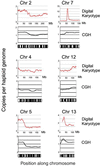Digital karyotyping
- PMID: 12461184
- PMCID: PMC138581
- DOI: 10.1073/pnas.202610899
Digital karyotyping
Abstract
Alterations in the genetic content of a cell are the underlying cause of many human diseases, including cancers. We have developed a method, called digital karyotyping, that provides quantitative analysis of DNA copy number at high resolution. This approach involves the isolation and enumeration of short sequence tags from specific genomic loci. Analysis of human cancer cells by using this method identified gross chromosomal changes as well as amplifications and deletions, including regions not previously known to be altered. Foreign DNA sequences not present in the normal human genome could also be readily identified. Digital karyotyping provides a broadly applicable means for systematic detection of DNA copy number changes on a genomic scale.
Figures




References
-
- Vogelstein B. & Kinzler, K. W., (2002) The Genetic Basis of Human Cancer (McGraw–Hill, New York).
-
- Scriver C. R., Beaudet, A. L., Sly, W. S. & Valle, D., (2001) The Metabolic and Molecular Bases of Inherited Disease (McGraw–Hill, New York).
-
- Kallioniemi A., Kallioniemi, O. P., Sudar, D., Rutovitz, D., Gray, J. W., Waldman, F. & Pinkel, D. (1992) Science 258, 818-821. - PubMed
-
- Lisitsyn N., Lisitsyn, N. & Wigler, M. (1993) Science 259, 946-951. - PubMed
-
- Schrock E., du Manoir, S., Veldman, T., Schoell, B., Wienberg, J., Ferguson-Smith, M. A., Ning, Y., Ledbetter, D. H., Bar-Am, I., Soenksen, D., et al. (1996) Science 273, 494-497. - PubMed
Publication types
MeSH terms
Substances
Grants and funding
LinkOut - more resources
Full Text Sources
Other Literature Sources
Research Materials

